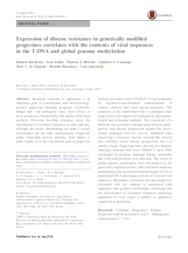Expression of disease resistance in genetically modified grapevines correlates with the contents of viral sequences in the T-DNA and global genome methylation.
Expression of disease resistance in genetically modified grapevines correlates with the contents of viral sequences in the T-DNA and global genome methylation.
Autoria: BOSCO, D. D.; SINSKI, I.; RITSCHEL, P. S.; CAMARGO, U. A.; FAJARDO, T. V. M.; HARAKAVA, R.; QUECINI, V.
Resumo: Increased tolerance to pathogens is an important goal in conventional and biotechnology-assisted grapevine breeding programs worldwide. Fungal and viral pathogens cause direct losses in berry production, but also affect the quality of the final products. Precision breeding strategies allow the introduction of resistance characters in elite cultivars, although the factors determining the plant?s overall performance are not fully characterized. Grapevine plants expressing defense proteins, from fungal or plant origins, or of the coat protein gene of grapevine leafroll-associated virus 3 (GLRaV-3) were generated by Agrobacterium -mediated transformation of somatic embryos and shoot apical meristems. The responses of the transformed lines to pathogen challenges were investigated by biochemical, phytopathological and molecular methods. The expression of a Metarhizium anisopliae chitinase gene delayed pathogenesis and disease progression against the necrotrophic pathogen Botrytis cinerea. Modified lines expressing a Solanum nigrum osmotin-like protein also exhibited slower disease progression, but to a smaller extent. Grapevine lines carrying two hairpin- inducing constructs had lower GLRaV-3 titers when challenged by grafting, although disease symptoms and viral multiplication were detected. The levels of global genome methylation were determined for the genetically engineered lines, and correlation analyses demonstrated the association between higher levels of methylated DNA and larger portions of virus-derived sequences. Resistance expression was also negatively correlated with the contents of introduced viral sequences and genome methylation, indicating that the effectiveness of resistance strategies employing sequences of viral origin is subject to epigenetic regulation in grapevine. Keywords Chitinase, Epigenetics, Fungus, Grapevine leafroll-associated virus 3, Pathogenesis related protein 5, Vitis
Ano de publicação: 2018
Tipo de publicação: Artigo de periódico
Unidade: Embrapa Uva e Vinho
Palavras-chave: Chitinase, Epigenetics, Fungus, Grapevine leafroll-associated virus 3, Pathogenesis related protein 5, Vitis
Observações
1 - Por padrão são exibidas publicações dos últimos 20 anos. Para encontrar publicações mais antigas, configure o filtro ano de publicação, colocando o ano a partir do qual você deseja encontrar publicações. O filtro está na coluna da esquerda na busca acima.
2 - Para ler algumas publicações da Embrapa (apenas as que estão em formato ePub), é necessário ter, no celular ou computador, um desses softwares gratuitos. Sistemas Android: Google Play Livros; IOS: iBooks; Windows e Linux: software Calibre.
Acesse outras publicações
Acesse a Base de Dados da Pesquisa Agropecuária (BDPA) para consultar o acervo completo das bibliotecas da Embrapa.

